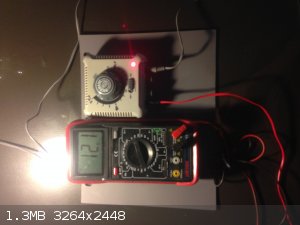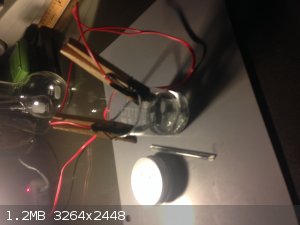Abromination
Hazard to Others
  
Posts: 432
Registered: 10-7-2018
Location: Alaska
Member Is Offline
Mood: 1,4 tar
|
|
Power Supply from Model Train Control
I was planning on spending the day building a power supply from scratch when I got the idea to modify a model train controller for the same use. This
obviously won't work for many types of controllers, although I have an older ones that directly supplies DC power to the nickel plated tracks powering
the train. This specific model like many changes the voltage depending on what speed you set it to, so it should work for a basic power supply,
although it won't be to accurate.
Has anyone else tried this?
List of materials made by ScienceMadness.org users:
https://docs.google.com/spreadsheets/d/1nmJ8uq-h4IkXPxD5svnT...
--------------------------------
Elements Collected: H, Li, B, C, N, O, Mg, Al, Si, P, S, Fe, Ni, Cu, Zn, Ag, I, Au, Pb, Bi, Am
Last Acquired: B
Next: Na
-------------- |
|
|
Abromination
Hazard to Others
  
Posts: 432
Registered: 10-7-2018
Location: Alaska
Member Is Offline
Mood: 1,4 tar
|
|
Update on this: It works like a freaking charm! I soldered some alligator clips onto the end of the DC adaptor that connects to the tracks and hooked
it up to my voltage meter and labeled a mark for every two volts. I proceeded to electrolyze a solution of sodium zincate and I am impressed with the
control I have over it. I would highly recommend this for someone who doesn't want to spend the money on a real one. My only complaint is that I have
no control over the amparage.
 
[Edited on 1-13-19 by Abromination]
List of materials made by ScienceMadness.org users:
https://docs.google.com/spreadsheets/d/1nmJ8uq-h4IkXPxD5svnT...
--------------------------------
Elements Collected: H, Li, B, C, N, O, Mg, Al, Si, P, S, Fe, Ni, Cu, Zn, Ag, I, Au, Pb, Bi, Am
Last Acquired: B
Next: Na
-------------- |
|
|
j_sum1
Administrator
       
Posts: 6218
Registered: 4-10-2014
Location: Unmoved
Member Is Offline
Mood: Organised
|
|
Nice idea.
|
|
|
diddi
National Hazard
   
Posts: 723
Registered: 23-9-2014
Location: Victoria, Australia
Member Is Offline
Mood: Fluorescent
|
|
the idea is good and you could use a lot of different power supplies with a little modification here and there. a trap for young players with train
controllers - new ones are often pulse width modulated so you might get unexpected results. 
Beginning construction of periodic table display
|
|
|
Abromination
Hazard to Others
  
Posts: 432
Registered: 10-7-2018
Location: Alaska
Member Is Offline
Mood: 1,4 tar
|
|
I'm sure you could modify anything with a DC output with a control dial for one, this was just what was most convinent at the time.
One of the big conveniences with the train controler is that it can easily be found at a garage sale, I have seen at least 4.
List of materials made by ScienceMadness.org users:
https://docs.google.com/spreadsheets/d/1nmJ8uq-h4IkXPxD5svnT...
--------------------------------
Elements Collected: H, Li, B, C, N, O, Mg, Al, Si, P, S, Fe, Ni, Cu, Zn, Ag, I, Au, Pb, Bi, Am
Last Acquired: B
Next: Na
-------------- |
|
|
phlogiston
International Hazard
    
Posts: 1375
Registered: 26-4-2008
Location: Neon Thorium Erbium Lanthanum Neodymium Sulphur
Member Is Offline
Mood: pyrophoric
|
|
But you do have control over the 'amperage' (more properly 'current').
The current is related to voltage by ohms law. V = I * R
Simplified, think of it like this:
When you increase the voltage output of your model train supply above the minimum needed for the reaction to occur at all, the 'extra' voltage is used
to overcome the ohmic resistance of the cell electrolyte, increasing the current flowing through the cell. This will speed up the reaction rate, but
also increase ohmic heating of the cell. At high currents, the amount of heating can be significant.
With a model train supply, the maximum output current is limited, so I don't think you'll heat up the cell significantly.
Alternatively, ohms law shows that you can also increase the current by decreasing R, i.e. the resistance of your cell. There are several ways you
could do that: Increase the concentration of ions in your electrolyte, increase the submerged area of the electrodes, or place the electrodes closer
together.
Incidentally, in your first post, you did not state what you were trying to do, so it would have been hard to advice whether a model train supply
would 'work' or not.
[Edited on 13-1-2019 by phlogiston]
-----
"If a rocket goes up, who cares where it comes down, that's not my concern said Wernher von Braun" - Tom Lehrer |
|
|
Sulaiman
International Hazard
    
Posts: 3555
Registered: 8-2-2015
Location: 3rd rock from the sun
Member Is Offline
|
|
A used Train Controller ... Excellent idea !
1) The unit is designed to be intrinsically 'safe' for children,
..... so should be safe enugh for most of us here.
2) Ready made enclosure
..... 'loose' modules tend to die or disappear
3) Variable voltage
..... allows any current up to the maximum capacity of the controller to be used/set
..... as above, electrode area and spacing with appropriate electrolyte conductivity determine current - at a given voltage.
4) the current capacity is sufficient for most aqueous electrolysis purposes other than bulk production for pyrotechnics etc.
..... it should be sufficient for a small chlorate cell - how much chlorate per day/week/month/year do you need ?
P.S. For 'serious' work you need to be able to measure cell voltage and current,
any multimeter is sufficient, e.g :
https://www.ebay.co.uk/itm/25E6-LCD-DT-830B-Tester-Meter-Mul...
but I use one of these :
https://www.ebay.co.uk/itm/ANENG-AN8002-Digital-Ture-RMS-600...
others may choose differently.
[Edited on 13-1-2019 by Sulaiman]
CAUTION : Hobby Chemist, not Professional or even Amateur
|
|
|
Abromination
Hazard to Others
  
Posts: 432
Registered: 10-7-2018
Location: Alaska
Member Is Offline
Mood: 1,4 tar
|
|
Quote: Originally posted by phlogiston  | But you do have control over the 'amperage' (more properly 'current').
The amperage is related to current by ohms law. V = I * R
Simplified, think of it like this:
When you increase the voltage output of your model train supply above the minimum needed for the reaction to occur at all, the 'extra' voltage is used
to overcome the ohmic resistance of the cell electrolyte, increasing the current flowing through the cell. This will speed up the reaction rate, but
also increase ohmic heating of the cell. At high currents, the amount of heating can be significant.
With a model train supply, the maximum output current is limited, so I don't think you'll heat up the cell significantly.
Alternatively, ohms law shows that you can also increase the current by decreasing R, i.e. the resistance of your cell. There are several ways you
could do that: Increase the concentration of ions in your electrolyte, increase the submerged area of the electrodes, or place the electrodes closer
together.
Incidentally, in your first post, you did not state what you were trying to do, so it would have been hard to advice whether a model train supply
would 'work' or not.
[Edited on 13-1-2019 by phlogiston] |
Did I not mention I have no control directly over current in my original post? It was my biggest complaint. I also mentioned that it was suitable
mostly just for simple electrolysis or running some equipment. I also do have prior understanding of Ohm's law.
I figured that for anything I planned to do with it would not cause a significant amount of heating.
In terms of multimeters, I have a nice one and hook it up to supply when I need them. Unfortunately, mine is quite old and I have no way to change the
batteries (they irreparably fall apart if yo do) so I may have to invest in something after all.
List of materials made by ScienceMadness.org users:
https://docs.google.com/spreadsheets/d/1nmJ8uq-h4IkXPxD5svnT...
--------------------------------
Elements Collected: H, Li, B, C, N, O, Mg, Al, Si, P, S, Fe, Ni, Cu, Zn, Ag, I, Au, Pb, Bi, Am
Last Acquired: B
Next: Na
-------------- |
|
|
Doped-Al2O3-fusion
Hazard to Self
 
Posts: 99
Registered: 11-4-2018
Member Is Offline
Mood: Maniacal
|
|
Quote: Originally posted by Abromination  | I was planning on spending the day building a power supply from scratch when I got the idea to modify a model train controller for the same use. This
obviously won't work for many types of controllers, although I have an older ones that directly supplies DC power to the nickel plated tracks powering
the train. This specific model like many changes the voltage depending on what speed you set it to, so it should work for a basic power supply,
although it won't be to accurate.
Has anyone else tried this? |
I've done it for small electrolysis cells, but it won't supply the amps you need for powering a DC motor if you need torque.
I'm more likely to die doing what I love. I'm a hobby chemist. I void warranties.
|
|
|
Texium
|
Thread Moved
29-11-2023 at 11:42 |
|